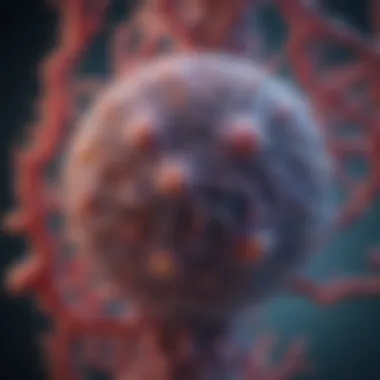siRNA and shRNA: Mechanisms and Applications Explained


Intro
The study of small interfering RNA (siRNA) and short hairpin RNA (shRNA) has become fundamental in molecular biology and genetics. These RNA molecules play critical roles in gene regulation, impacting how organisms express traits and respond to their environments. This article aims to dissect the complexities surrounding siRNA and shRNA, providing insights into their mechanisms, applications, and recent advancements.
Understanding these RNA molecules is essential not only for researchers but also for educators and professionals in the life sciences. By exploring the methodologies and technologies that underpin their development, we can appreciate their significance in both research and clinical applications.
Research Overview
Key Findings
Research has shown that siRNA and shRNA are instrumental in the RNA interference (RNAi) pathway, leading to the silencing of specific genes. siRNA is typically introduced directly into cells, whereas shRNA is expressed from a DNA vector, making it a powerful tool for stable gene knockdown.
- siRNA provides quick gene silencing; however, its effects are transient.
- shRNA offers longer-lasting knockdown effects as it can integrate into the cellular genome.
- Both tools have been successfully applied in therapeutics targeting diseases such as cancer, viral infections, and genetic disorders.
Study Methodology
Recent studies have adopted various approaches to investigate siRNA and shRNA functionalities, including in vitro experiments, in vivo models, and high-throughput screenings. These methodologies enhance our understanding of how RNA molecules interact with cellular components and influence gene expression. Key methods include:
- Microarray Analysis: Used to evaluate gene expression changes post-transfection of siRNA or shRNA.
- Western Blotting: To confirm the downregulation of targeted proteins.
- CRISPR Techniques: Emerging tools that allow for precise editing alongside RNA interference methods.
Background and Context
Historical Background
The discovery of RNA interference in 1998 revolutionized molecular biology. Researchers Andrew Fire and Craig Mello demonstrated that double-stranded RNA could trigger the degradation of homologous mRNA, a foundational principle for both siRNA and shRNA functions. Since then, advancements have led to the refinement of these technologies, allowing for their application in a diverse range of research domains.
Current Trends in the Field
In recent years, the field has seen an increasing trend towards the therapeutic use of siRNA and shRNA. Clinical trials are underway for various conditions, with a focus on developing targeted therapies that minimize off-target effects. Innovations in delivery methods, such as lipid nanoparticles or viral vectors, have also emerged to enhance the efficacy of these RNA molecules.
This article will delve deeper into the workings of siRNA and shRNA, their comparative benefits, limitations, and expanding relevance in contemporary molecular biology. By synthesizing clinical applications, methodologies, and their underlying mechanisms, the audience will gain a thorough understanding of these powerful tools.
Prolusion to RNA Interference
RNA interference (RNAi) is a fundamental biological process that plays a crucial role in regulating gene expression. This process involves small RNA molecules that can specifically target and silence genes. Understanding RNAi is essential for grasping how siRNA and shRNA can be utilized in both research and therapeutic settings. The importance of this topic lies in its potential to manipulate gene expression, offering insights into various genetic diseases. This section aims to present an overview of RNA interference, emphasizing its significance in the field of molecular biology.
Overview of RNA Interference Mechanism
RNA interference operates through a series of well-orchestrated steps that involve double-stranded RNA (dsRNA) processing into smaller fragments. These fragments mainly comprise small interfering RNA (siRNA) and short hairpin RNA (shRNA). The process begins with the recognition of dsRNA by the enzyme Dicer, which cleaves it into 20-25 nucleotide fragments. These siRNA molecules are then incorporated into the RNA-induced silencing complex (RISC). Within RISC, the passenger strand is removed, leaving the guide strand. The guide strand then binds to complementary messenger RNA (mRNA) sequences, leading to mRNA degradation or translational inhibition. Consequently, RNA interference serves as a powerful tool for downregulating specific genes, highlighting its utility in both research and therapy.
Historical Perspective of RNA Interference Discovery
The discovery of RNA interference dates back to the late 1990s, wherein researchers observed the unexpected effects of dsRNA in Caenorhabditis elegans. Andrew Fire and Craig Mello, in 1998, identified that introducing dsRNA could lead to sequence-specific gene silencing. Their work established a foundation for understanding the mechanisms behind RNAi. In recognition of their groundbreaking research, they were awarded the Nobel Prize in Physiology or Medicine in 2006. Over the years, RNA interference has evolved into a pivotal area in genetics, enabling scientists to explore gene function and develop innovative therapeutic strategies for diseases such as cancer and viral infections. As research continues to advance, the historical significance of RNA interference remains a cornerstone in the landscape of molecular biology.
Understanding siRNA
The exploration of small interfering RNA (siRNA) is critical in understanding the broader context of RNA interference. siRNA plays a vital role in gene regulation and offers powerful tools for both research and therapeutic applications. This section delves into the definition, structure, biogenesis, mechanisms, design principles, and applications of siRNA, highlighting its significance in modern molecular biology.
Definition and Structure of siRNA
siRNA are short, double-stranded RNA molecules, typically 20-25 nucleotides in length. They are characterized by their ability to induce the degradation of specific messenger RNA (mRNA) targets through a process known as RNA interference. The typical structure includes a two-nucleotide 3' overhang at each end, which is essential for their function. This structural configuration enables siRNA to bind to the RNA-induced silencing complex (RISC), leading to gene silencing.
Biogenesis of siRNA
siRNA are generated from longer double-stranded RNA (dsRNA) precursors. This process is facilitated by an enzyme known as Dicer, which cleaves the dsRNA into 21-23 base pair fragments. Once formed, these siRNA molecules are incorporated into the RISC, where they guide the complex to complementary mRNA sequences. This biogenesis pathway is crucial as it determines the specificity and efficacy of siRNA in silencing target genes.
Mechanism of Action in Gene Silencing
The mechanism of action involves a series of steps after siRNA is incorporated into RISC. The single-stranded siRNA guides the RISC to its target mRNA by base-pairing. Once bound, the endonuclease activity of Argonaute, a key protein within RISC, degrades the mRNA. This degradation prevents the mRNA from being translated into a protein, effectively silencing the expression of the target gene.


"siRNA can be a potent tool for selectively silencing genes, making it invaluable in both research and therapeutic settings."
Design Principles for Effective siRNA
Designing effective siRNA requires careful consideration of several factors:
- Target Selection: Choosing a target mRNA that is accessible and has a unique sequence helps improve specificity.
- Sequence Design: Avoiding sequences that resemble off-target genes helps reduce unintended effects. Tools like the RNAi Consortium can assist in targeting selection.
- Chemical Modifications: Modifying the siRNA with chemical moieties can enhance stability and decrease the immune response.
- Testing: Empirical testing in vitro can help refine the design by evaluating the efficiency and specificity of the siRNA.
Applications of siRNA in Research
siRNA has revolutionized research methodologies. Its applications range from functional genomics to validation of gene function. Researchers utilize siRNA to knock down gene expression, allowing them to dissect pathways and understand cellular processes. This makes siRNA an essential tool for studying complex diseases and uncovering molecular mechanisms.
Therapeutic Potential of siRNA
The therapeutic potential of siRNA is expansive. It has been explored in treating various diseases, including cancer, viral infections, and genetic disorders. Clinical trials have shown promise, particularly with the development of siRNA-based therapies like Patisiran for amyloidosis. siRNA provides a novel approach to directly target disease-causing genes, presenting an innovative avenue for developing personalized medicine.
Exploring shRNA
Short hairpin RNA, commonly known as shRNA, represents an essential component of the RNA interference mechanism. It is crucial for researchers and professionals to understand shRNA, as it offers numerous benefits in manipulating gene expression. Notably, shRNA is designed to induce long-lasting gene silencing, making it a powerful tool in various biological and therapeutic applications.
Definition and Structure of shRNA
shRNA consists of a sequence of about 20-25 nucleotides, which forms a stem-loop structure. This structure is crucial for its function. The stem part of the shRNA, created by complementary base pairing, allows the RNA to assume a stable configuration. On the other hand, the loop provides flexibility, separating the two ends of the stem. This unique structure is vital for its processing and subsequent gene silencing ability.
Biogenesis of shRNA
The biogenesis of shRNA involves several steps. Firstly, shRNA is usually transcribed from a DNA template, often using a polymerase to create long RNA strands. Once formed, the nuclear enzyme Dicer processes these long strands into shorter interfering RNAs. The resulting mature shRNA is then incorporated into the RNA-induced silencing complex (RISC), which facilitates the target RNA's degradation. This process emphasizes the complex interplay between shRNA and cellular machinery, making its understanding vital for its application in research and potential therapies.
Mechanism of Gene Silencing by shRNA
The mechanism by which shRNA silences genes is through its interaction with complementary mRNA molecules. When shRNA is incorporated into RISC, it guides the complex to the target mRNA based on sequence complementarity. Once aligned, RISC cleaves the mRNA, leading to its degradation. This action prevents the translation and expression of the targeted gene. Understanding this mechanism is imperative, especially in designing experiments that require gene knockdown, and adds depth to the exploration of shRNA functionality.
Designing Effective shRNA Constructs
Developing effective shRNA constructs is not trivial and requires careful design considerations. Factors such as target site selection, avoiding off-target effects, and ensuring the stability of the shRNA construct are essential. Specific guidelines, like avoiding sequences that may cause immune responses or ensuring that the shRNA has a favorable melting temperature, can significantly enhance its efficacy. Learning these principles aids in maximizing shRNA's potential in research and therapeutic contexts.
Applications of shRNA in Molecular Biology
shRNA has various applications in molecular biology. One of its primary uses is in functional genomics, where it helps researchers investigate gene function through silencing. It also plays a role in genetic screens, allowing for the exploration of gene networks. Furthermore, shRNA is increasingly used in studies concerning disease mechanisms, particularly in cancer research, where specific gene knockdowns can shed light on tumorigenesis pathways.
Potential Therapeutic Applications of shRNA
The therapeutic potential of shRNA is vast. Its ability to silence disease-causing genes offers a novel approach to treating various conditions, including cancer, viral infections, and genetic disorders. Clinical trials are underway exploring shRNA-based therapies, such as targeting oncogenes in specific cancers. However, careful consideration must be given to the delivery mechanisms and the potential for off-target effects to ensure safety and efficacy in treatment regimens.
"Understanding shRNA provides researchers with tools to manipulate gene expression, opening up possibilities for innovative treatments and deeper insights into genetic functions."
As interest in RNA interference grows, the role of shRNA becomes increasingly significant. This exploration not only highlights the mechanisms and design principles but also paves the way for future innovations in research and therapeutic applications.
Comparative Analysis: siRNA vs shRNA
The comparative analysis of small interfering RNA (siRNA) and short hairpin RNA (shRNA) is crucial in understanding their distinct roles in RNA interference pathways. Both play critical roles in gene silencing, yet they differ fundamentally in structure, function, and applications. This section explores the key differences between siRNA and shRNA, illuminating their advantages and disadvantages for research and therapeutic purposes.
Mechanistic Differences
siRNA and shRNA have different mechanisms to induce gene silencing, despite both using the RNA interference pathway. siRNAs are typically short, double-stranded RNA molecules measuring approximately 21-23 nucleotides in length. They are incorporated into the RNA-induced silencing complex (RISC), which facilitates the sequence-specific degradation of complementary mRNA.
In contrast, shRNA is a synthetically produced RNA sequence that forms a hairpin structure. This structure allows it to be processed by the Dicer enzyme into functional siRNAs within the cell. Hence, shRNA acts as a precursor to siRNA, providing continual gene silencing as long as the shRNA construct is expressed.
"Understanding the mechanistic differences between siRNA and shRNA is essential for choosing the appropriate tool for gene silencing experiments."
Efficacy in Gene Knockdown


Efficacy is a key consideration when utilizing siRNA or shRNA for gene knockdown in experimental setups. siRNA generally exhibits a quick, targeted action resulting in immediate mRNA degradation and subsequent protein depletion. This is beneficial for short-term studies where rapid results are required.
In contrast, shRNA offers long-term knockdown effects. Since shRNA molecules are integrated into the host genome using vector systems, they provide a stable means of gene silencing. This makes shRNA particularly advantageous for applications requiring sustained suppression of target genes. However, the onset of action may be slower due to the time needed for transcription and processing.
Delivery Methods for siRNA and shRNA
The effectiveness of siRNA and shRNA is significantly influenced by the delivery methods employed to introduce these molecules into target cells. siRNA typically relies on non-viral delivery systems such as liposomes and nanoparticles, which can effectively protect the fragile RNA from degradation and aid their entry into cells.
ShRNA, being expressed from a vector (often a plasmid or viral system), can be delivered using viral vectors that efficiently transduce cells, providing a more direct introduction into the cellular machinery. The choice of delivery method can significantly affect the outcome of experiments.
Cost-Efficiency and Scalability
Cost-efficiency is an important factor in the comparative analysis of siRNA and shRNA. Typically, siRNA can be synthesized for individual experiments at a lower initial cost. However, the need for repeated production of siRNA for long-term studies can outweigh this advantage.
In contrast, shRNA constructs, once integrated into a stable cell line, require only the initial investment in vector design and molecular cloning. This can be more cost-effective in the long run, especially for large-scale production or in studies involving multiple experiments over an extended period. The choice will depend on experimental needs, considering both immediate results and long-term viability.
Overall, the analysis of siRNA and shRNA side by side allows researchers to make informed decisions tailored to their specific experimental requirements, optimizing their gene silencing efforts.
Delivery Systems for RNA-based Interventions
The importance of RNA delivery systems cannot be overstated. Effective delivery systems are critical for the successful application of siRNA and shRNA in both research and therapeutic contexts. These systems determine how well RNA molecules reach their target cells and perform their function. The efficiency of these delivery methods is influenced by multiple factors such as cellular uptake, biocompatibility, and expression duration. Understanding these systems enables researchers to maximize the potential of RNA interference technology.
Viral Vectors for siRNA and shRNA
Viral vectors have emerged as powerful tools for delivering siRNA and shRNA into cells. These are typically modified viruses designed to transport genetic material without causing disease. Common viral vectors include lentivirus, adenovirus, and adeno-associated virus (AAV). Each of these has unique properties that influence their use:
- Lentivirus: Capable of integrating into the host genome, making it useful for long-term expression of shRNA.
- Adenovirus: Non-integrating and offers high transduction efficiency, ideal for delivering siRNA for transient applications.
- AAV: Known for its low immunogenicity and ability to target specific cell types, which is beneficial for therapies aimed at specific diseases.
Viral vectors can achieve high transfection rates, but their use also comes with challenges. Safety, potential immunogenic responses, and the risk of insertional mutagenesis must be considered.
Non-Viral Delivery Methods
Non-viral methods for RNA delivery offer several advantages, such as lower immunogenicity and greater control over the dosing regimen. Among these, lipid nanoparticles, polymer-based systems, and electroporation stand out.
- Lipid Nanoparticles: These can encapsulate RNA molecules and facilitate their entry into cells via endocytosis. They are well-studied and can effectively deliver both siRNA and shRNA.
- Polymer-Based Systems: Polymers like polyethyleneimine (PEI) can condense RNA into nanoparticles and enhance cellular uptake. They allow for flexible design and tunability.
- Electroporation: This technique applies an electrical field to increase cell membrane permeability, enabling efficient RNA intake.
Each of these methods has specific scenarios where it excels. For example, lipid nanoparticles are excellent for clinical applications due to their ability to encapsulate mRNA in vaccines.
Challenges in Delivery
Despite advances, challenges in RNA delivery persist. Some of the main obstacles include:
- Targeting: Directing RNA specifically to target cells remains a significant challenge, especially in complex organisms.
- Stability: RNA is inherently unstable, which can lead to degradation before reaching its target.
- Cellular Uptake: Efficient delivery requires overcoming cellular barriers, which varies by cell type and tissue.
- Immunogenicity: Viral vectors, while effective, can trigger immune responses that limit their utility.
Addressing these challenges is crucial for the development of effective therapeutics based on RNA interference.
Recent Advances in siRNA and shRNA Research
The field of RNA interference, particularly involving siRNA and shRNA, is continually evolving. Recent advancements are essential as they pave the way for new therapeutic applications and enhance our understanding of gene regulation. This section highlights specific elements that have surfaced in recent years, emphasizing the benefits and considerations surrounding these innovations.
Innovative Therapeutic Strategies
Recent innovations in therapeutic applications of siRNA and shRNA have shown significant promise. One key strategy is the enhancement of specificity and efficiency in targeting disease-related genes. Researchers are employing chemical modifications to the RNA molecules, which can improve stability and reduce off-target effects. Consequently, this leads to more effective treatments with fewer side effects.
Additionally, combination therapies utilizing siRNA or shRNA with other modalities, such as small molecules or monoclonal antibodies, have shown better outcomes in preclinical studies. This approach can enhance the overall effectiveness of treatments in conditions like cancer and genetic disorders.
Key points include:
- Higher specificity achieved through chemical modifications.
- Combination approaches yielding improved results.
- Reductions in off-target effects leading to safer therapies.


Emerging Technologies and Platforms
As research advances, new technologies are constantly being developed to facilitate the delivery of siRNA and shRNA. For instance, the use of nanoparticle-based delivery systems has gained traction. These systems can efficiently transport the RNA molecules to target cells while minimizing degradation in the bloodstream. Some nanoparticles can even be engineered to respond to specific cellular environments, allowing for more precise delivery of therapeutics.
Furthermore, CRISPR technology has made notable contributions. While traditionally associated with genome editing, researchers are exploring its potential to enhance the efficacy of siRNA and shRNA therapies. The integration of these approaches creates a more robust method of gene silencing, often increasing efficiency in adjusting gene expression.
Important aspects include:
- Nanoparticle systems for targeted delivery.
- CRISPR integration to amplify silencing capabilities.
- Enhanced stability and efficacy of RNA therapeutics.
Future Directions in Research
Looking forward, several paths of research promise to shape the future of siRNA and shRNA applications. One promising direction is the optimization of delivery mechanisms. Continuing to refine these methods will be crucial for the transition of laboratory successes into clinical practice.
Another area of focus is on the personalized medicine approach. By analyzing genetic profiles of patients, tailored RNA therapies can be designed to maximize efficacy while minimizing adverse effects. This patient-centric model is gaining support in the scientific community.
Moreover, the exploration of non-coding RNAs as potential therapeutic targets will expand our understanding of gene regulation further. Their involvement in disease progression presents an opportunity for new interventions.
Future research should prioritize:
- Improving delivery mechanisms for clinical applications.
- Advancing personalized RNA therapies.
- Investigating non-coding RNAs in disease contexts.
Ultimately, the recent advances in siRNA and shRNA research signal a transformative phase in molecular biology. The innovations not only hold therapeutic potential but also cultivate a deeper understanding of gene expression and regulation.
Ethical Considerations in RNA Interference
The use of RNA interference (RNAi) technologies, such as small interfering RNA (siRNA) and short hairpin RNA (shRNA), presents significant ethical considerations that researchers and practitioners must address. As the capabilities of these RNA-based therapies expand in both research and clinical applications, it is paramount to examine the ethical implications surrounding their use, especially concerning safety and regulatory measures.
Ethical considerations encompass a variety of factors, including the risks involved in manipulating genetic material, issues of consent, and the broader societal implications of RNA technologies. The potential for unintended consequences in gene alteration raises concerns about long-term effects on individuals and populations. Communication of these risks to both the scientific community and the public is essential. Therefore, addressing ethical concerns is not merely an afterthought but a vital part of the development and implementation process for RNAi therapies.
Safety Concerns with siRNA and shRNA
Safety is one of the foremost ethical concerns associated with siRNA and shRNA technologies. The primary issue lies in the possibility of off-target effects, where the RNA molecules may inadvertently silence unintended genes. This could lead to harmful consequences, including unexpected cellular responses and adverse side effects in therapeutic applications. Specific safety considerations include:
- Off-target silencing: The design of RNA molecules must be precise to minimize unintended interactions.
- Long-term effects: Since RNAi could permanently alter gene expression, the sustainability of these changes over time needs evaluation.
- Immune responses: siRNA and shRNA may trigger immune reactions that could compromise patient safety.
To mitigate these risks, rigorous testing and validation processes are necessary before clinical applications can proceed.
Regulatory Framework for RNA-based Therapies
The regulatory landscape for RNA-based therapies is integral to ensuring their ethical use. National and international regulations must adapt to address the unique challenges posed by RNAi technologies. Regulatory agencies like the U.S. Food and Drug Administration (FDA) and the European Medicines Agency (EMA) are gradually establishing frameworks specifically for RNA therapies. This includes oversight of the development processes, clinical trials, and post-marketing surveillance.
Key points in the regulatory framework include:
- Preclinical testing: Rigorous assessments must be conducted to evaluate the safety and efficacy of siRNA and shRNA before human trials.
- Informed consent: Participants in clinical trials must understand the risks involved in RNA-based therapies, ensuring proper consent procedures.
- Monitoring and reporting: Ongoing surveillance of RNA therapies in practice is essential to quickly identify any adverse effects or ethical concerns that arise post-approval.
Regulation must keep pace with scientific advancements to effectively manage the ethical landscape surrounding RNA interference technologies.
Overall, navigating the ethical considerations in RNA interference is not merely an academic exercise; it is a crucial component that ensures the responsible development and application of these influential biotechnologies.
The End
In bringing together the insights discussed in this article, it is clear that small interfering RNA (siRNA) and short hairpin RNA (shRNA) are pivotal tools in molecular biology. The understanding of their mechanisms, applications, and the recent advancements underscores their importance in gene regulation.
Summary of Key Points
The main points from this article include the following aspects:
- Mechanistic Insights: siRNA and shRNA work through RNA interference (RNAi) pathways to silence gene expression, but they differ in their structure and modes of delivery.
- Design and Synthesis: The design principles for siRNA and shRNA vary significantly, affecting their efficacy and the kind of cellular response elicited.
- Applications: Both siRNA and shRNA have significant implications in research, particularly for gene knockdown experiments, as well as therapeutic contexts targeting diseases.
- Delivery Systems: Exploring various delivery methods, including viral and non-viral vectors, is crucial to optimize the effectiveness of these RNAi molecules.
- Ethical Considerations: Safety concerns and regulatory frameworks are necessary to ensure responsible developments in RNA-based therapies.
Implications for Future Research and Therapy
The future directions for research on siRNA and shRNA promise to enhance their utility in clinical applications. Here are several implications worth noting:
- Targeting Complex Diseases: The potential for siRNA and shRNA in targeting diseases like cancer and genetic disorders remains vast. Further research is needed to refine their specificity and minimize off-target effects.
- Innovative Delivery Methods: Future studies should emphasize developing novel delivery systems to increase the bioavailability and cellular uptake of these molecules. Non-viral methods are particularly promising.
- Regulatory Advancements: Continuous dialogue among researchers, policymakers, and ethicists will shape the regulatory landscape, ensuring the safety and efficacy of RNA-based therapies before their wider clinical adoption.
In summary, as the field of genetic research develops, siRNA and shRNA will undoubtedly take center stage, providing insights into gene function and leading to innovative therapeutic strategies.







